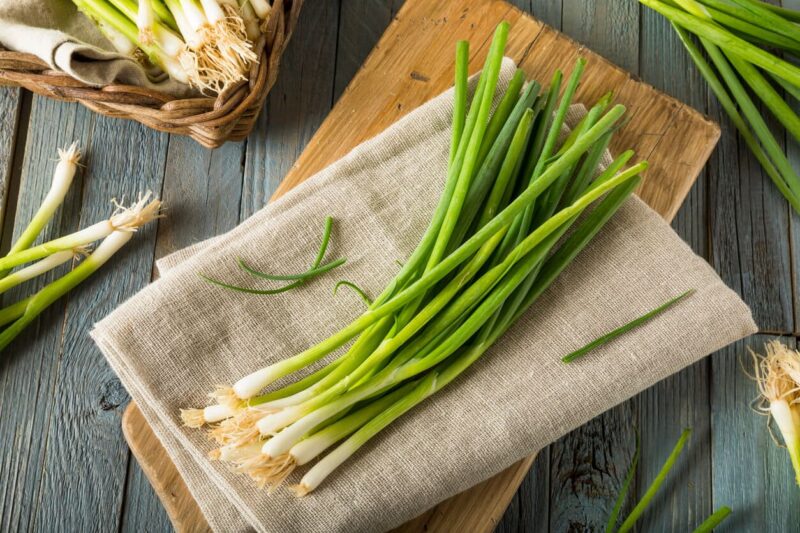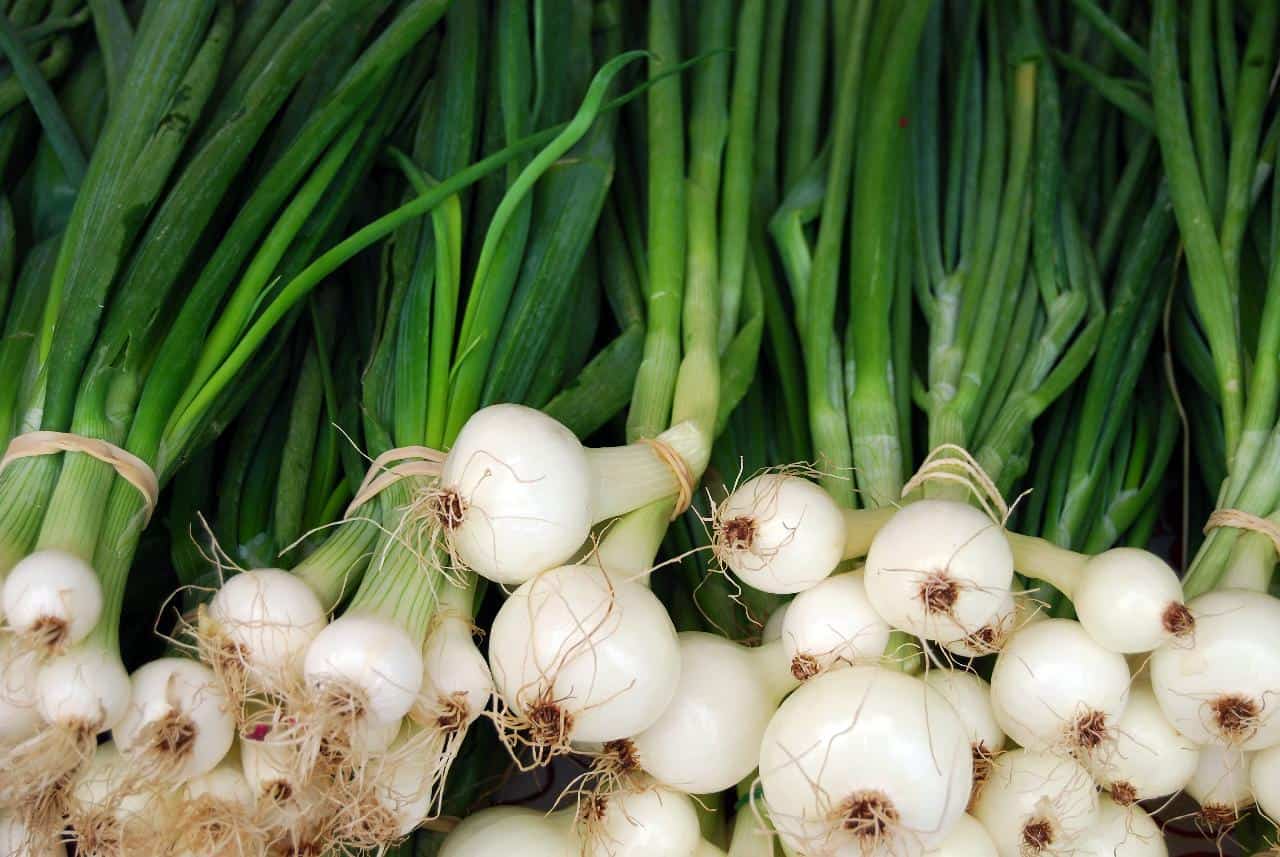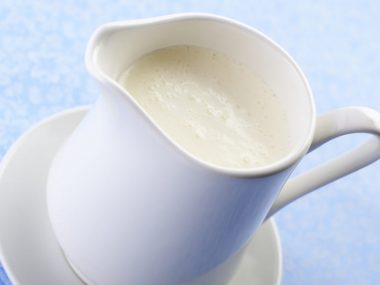Both chives and green onions belong to the allium family along with shallots, scallions, garlic, and leeks.
Chives have long, thin green stalks and a mild onion-garlic flavor. They also grow blossoms with beautiful purple colors and mild onion-garlic flavor.
That being said, let’s take a look at both chives and green onions and learn more about the key differences between the two.
Chives
The green chives stalks are often used fresh as a garnish, and they are added to dressings, cream cheese, dips, salads, soups, sauces, potato, and egg dishes.
The blossoms are also used as a garnish to give beautiful purple color to many dishes. And since chives have a very mild flavor, they are added at the end of the cooking to keep their fresh, light flavor.
You can buy chives in the supermarkets, where they are sold in bunches. However, because they don’t stay fresh long, you have to store them properly.
To keep them fresh, you can keep them in the refrigerator in a jar half full of water or wrapped in a paper towel inside of a plastic zip-top bag.
They will stay nice and fresh in the refrigerator for about 10-14 days if you can keep them dry and prevent mold from forming.
Green Onions
Green onions can also be found under other names like scallions or spring onions. They are all slightly different because green onions and scallions have not fully developed and smaller bulbs than spring onions.
Green onions have long green stalks and white bulbs. Both parts have different flavors.
The white part of the green onions has a stronger onion flavor than the green stalks which have a fresh -grassy onion flavor.
Green onions can be used raw and cooked in many recipes. They blend amazingly in stir-fries, salad dressings, marinades, dips, and sauces.
Green onions, on the other hand, work well in cooked dishes they are usually added at the end of the cooking to keep them nice and crispy. Green onions also taste amazing roasted or grilled or sprinkled as a garnish on top of soups, rice, or potato puree.
You can keep green onions fresh if you put them in a glass jar half full of water. Just rinse the green onions and place them with the white parts in the bottom of the jar. Cover the onions with a plastic bag, secure the bag around the jar with a rubber band, and put it in the fridge.
Your green onions will stay fresh for about one week.
Another way to keep green onions fresh is to wrap them in paper towels. Simply rinse the green onions, pat dry to remove the excess water with paper towels, and wrap them with paper towels, to keep them fresh for 3-4 days.
Chives vs Green Onion: What’s the Difference?
Even though they belong to the same family, chives and green onion have differences. The first one you can notice is in their appearance.
Chives have long green and thin stalks and are smaller than green onions, whereas green onions have bigger and thicker stalks and white bulbs.
Chives are very tender and delicate and are often consumed raw or slightly cooked to keep their nice green color and mild flavor. Green onions, on the other hand, are used raw and cooked and they are one of the ingredients in many dishes.
Chives have a mild onion-garlic flavor which is similar but not the same as that of greener parts of the green onion. The white bulbs of the green onion have a stronger onion flavor and are used as a base in many recipes like stir-fries, soups, and sauces.
Chives vs Green Onion Comparison Chart
| Specie | Chives (Allium schoenoprasum) | Green onion (Allium fistulosum) |
| Appearance | Long, thin, green stalks | Long, thicker, and wider, green stalks, and white bulbs |
| Consumed form | Raw | Raw and cooked |
| Culinary use | As a garnish and herb | As a cooking ingredient, and a garnish |
| Flavor | Mild onion flavor with a hint of garlic | The white bulbs have a stronger onion flavor, and the green stalks have a fresh-grassy onion flavor |
Chives vs Green Onions Nutrition
Chives and green onions are good sources of vitamins minerals and antioxidants. But they are also low in calories which makes them a healthy ingredient that can be used in many recipes.
According to the USDA, chives have vitamins A, C, and K, calcium, potassium, magnesium, phosphorus, and folate. Green onions, on the other hand, have A, C, K, E, and B3 vitamins, folate, calcium, magnesium, potassium, phosphorus, sodium, iron, and selenium.
Green Onions vs Chives on Baked Potatoes
Baked potatoes are a side dish you can pair with many different main dishes like steaks, chicken, pork chops, meatloaf, grilled meat, grilled portobello mushrooms, and more. However, they also work well with butter, sour cream, cheese, parsley, chives, and green onions as a topping.
You can use either chop chives or green onion and sprinkle on top of your baked potatoes. Which one you are going to use depends on what flavor you want to get.
If you want baked potatoes with a stronger onion flavor, use the chopped green stalks of the green onions. But if you like milder onion flavor add the chopped chives as a topping for your baked potatoes.
Restaurants often use green onion as a topping for baked potatoes due to their low price. They are also less delicate than chives.
You can also use green onions instead of chives as a topping but chopped into small pieces and in small amounts. That way, you will avoid the strong onion flavor they provide.
Can I Substitute Chives for Green Onions?
You can substitute chives for green onions.
However, they have a milder flavor than green onions, so you will have to use larger amounts to get a similar flavor to the flavor of the green onions.
For one medium-size green onion, you can use 2-3 tablespoons of chopped chives.
Which is Better Chives or Green Onions?
They both taste amazing and which one you pick depends on which dish you want to use them for and what flavor you want to achieve.
If you need a garnish with mild onion flavor, use chives. However, if you prefer a stronger onion flavor, opt for green onions.
They are used both raw and cooked in different salads, stir-fries, or sprinkled over soup, rice, or some other cooked dish.
Do Chives Taste Like Onions?
Chives taste like onions, however, they have a milder flavor than the regular onions. Their flavor can be described as onions with a hint of garlic. Chives are best used fresh chopped and sprinkled over salads, creamy sauces, grilled meat, or fish.
Are Chives and Scallions Different?
Chives and scallions are different in many ways.
They are different in look, flavor, and the way they are used. Chives have long green stalks, mild onion-garlic flavor and they are usually used as a garnish.
Scallions are younger green onions with green wide stalks and white bulbs. They also have a stronger onion flavor than chives and they are used both raw and cooked in different recipes.
Why Are Chives so Expensive?
Chives cost a lot because they have a delicate texture. Additionally, they can be easily spoiled if they are not stored properly. If chives have a bad odor, soft texture, pale green color, or they are wilted you should not buy or use them.
What Do You Prefer?
Chives and green onions are the most used types of onions in kitchens in the world. Even if they belong to the same family, they have differences and are used in different ways.
Now when you know how and why they are different you can choose which one you are going to use in your recipes to get the best results.




